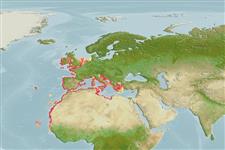Common names from other countries
>
Carangiformes (Jacks) >
Carangidae (Jacks and pompanos) > Naucratinae
Etymology: Campogramma: Greek, kampe, -es = curvature, bent + Greek, gramma = mark, signal, letter (Ref. 45335).
More on author: Lacepède.
Environment: milieu / climate zone / depth range / distribution range
Ecología
marino bentopelágico; rango de profundidad 15 - 30 m (Ref. 7097). Subtropical; 56°N - 12°N, 26°W - 27°E
Eastern Atlantic: British Isles to Senegal including Madeira and the Canary Islands. Also western Mediterranean Sea.
Tamaño / Peso / Age
Maturity: Lm ? range ? - ? cm
Max length : 60.0 cm FL macho / no sexado; (Ref. 3397); common length : 58.0 cm TL macho / no sexado; (Ref. 3397); peso máximo publicado: 2.8 kg (Ref. 27584)
Short description
Claves de identificación | Morfología | Morfometría
Espinas dorsales (total) : 7; Radios blandos dorsales (total) : 30; Espinas anales: 2; Radios blandos anales: 23 - 24.
Caught with bottom and pelagic trawls. Adults are pelagic or epibenthic (Ref. 7097) mostly in shallow waters. They feed mainly on schooling fishes (Ref. 4233). Eggs are pelagic (Ref. 4233).
Life cycle and mating behavior
Maturities | Reproducción | Spawnings | Egg(s) | Fecundities | Larva
Smith-Vaniz, W.F., 1986. Carangidae. p. 815-844. In P.J.P. Whitehead, M.-L. Bauchot, J.-C. Hureau, J. Nielsen and E. Tortonese (eds.) Fishes of the north-eastern Atlantic and the Mediterranean. UNESCO, Paris. vol. 2. (Ref. 4233)
IUCN Red List Status (Ref. 130435)
CITES (Ref. 128078)
Not Evaluated
Threat to humans
Harmless
Human uses
Pesquerías: escaso valor comercial; pesca deportiva: si
Herramientas
Special reports
Download XML
Fuentes de Internet
Estimates based on models
Preferred temperature (Ref.
115969): 10.3 - 20.7, mean 16.1 (based on 88 cells).
Phylogenetic diversity index (Ref.
82804): PD
50 = 1.0000 [Uniqueness, from 0.5 = low to 2.0 = high].
Bayesian length-weight: a=0.01413 (0.00618 - 0.03226), b=2.94 (2.74 - 3.14), in cm Total Length, based on LWR estimates for this (Sub)family-body shape (Ref.
93245).
Nivel trófico (Ref.
69278): 4.5 ±0.80 se; based on food items.
Resiliencia (Ref.
120179): Medio, población duplicada en un tiempo mínimo de 1.4-4.4 años (Preliminary K or Fecundity.).
Fishing Vulnerability (Ref.
59153): Moderate to high vulnerability (47 of 100).
